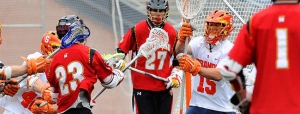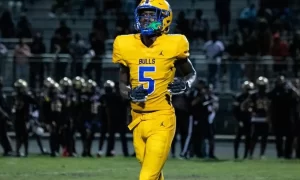Will Syracuse’s loss in the NCAA tournament lead to a major rules change for lacrosse? The scene was all too familiar. An unseeded team rushing the field after stunning a favored SU squad in overtime to end Orange dreams of a national title.
This time it was Maryland who stalled its way to a 6-5 win over SU, sending the Terps to Baltimore for the Final Four and the Orange back to the drawing board. It’s a devastating way for seniors like John Galloway, fan favorite Jovan Miller and Joel White to go out. Their legacy is once again a source of discussion, but maybe more importantly this loss heightened¬†the need for a shot clock or a stricter way to increase pace.
The accolades of the 2011 class has been dissected here before, with multiple All-Americans part of two title teams. The legacies of guys like White, Keogh, Lade and Galloway will certainly live on at Syracuse, but the last two seasons left quite a bit to be desired. In the last two years the Orange twice entered the tournament as a top-two seed and prohibitive favorites for the Final Four and came up short. Last year it was Army who stunned SU in the first round, while this year Maryland took the Orange out in the second. These losses have raised questions about the upperclassmen in the clutch.
This group of seniors won as freshmen and sophomores, but couldn‚Äôt get it done when they were handed the reins as leaders. The only major contributors from this class on the 2008 title team were White, Galloway and Keogh. In ’09 those three, along with Lade and Josh Amidon, had a hand in the title. But the Final Four teams were Mike Leveille and Kenny Nims‚Äô teams. For the class of ’11 this loss doesn‚Äôt crush its legacy. The group will still go down as a top 10 class in Syracuse lacrosse, which is quite an honor. But with this ending, the ’11 boys fall out of the all-time top 5.
The other major issue of concern after this loss is the desperate need to stop the tactic of stalling. Lacrosse has branded itself “the fastest sport on two feet,” but Maryland slowed the game to a halt, receiving double-digit stall warnings and winning by the lowest score ever against a Syracuse team in the tournament.
Maryland is by no means the first team to use this method against the ‘Cuse. The Terps employed a strategy most of SU’s opponents attempted: limit possessions and shorten the game. There are two possible options the NCAA could utilize to prevent that strategy. Institute a shot clock or initiate a more standardized and strict stall rule.
The senior class will forever be haunted by this loss, but if it spurs a rule change that gray day in Foxboro could ultimately benefit the Orange and coach John Desko in the long run.
Posted: Alex Plavin


















